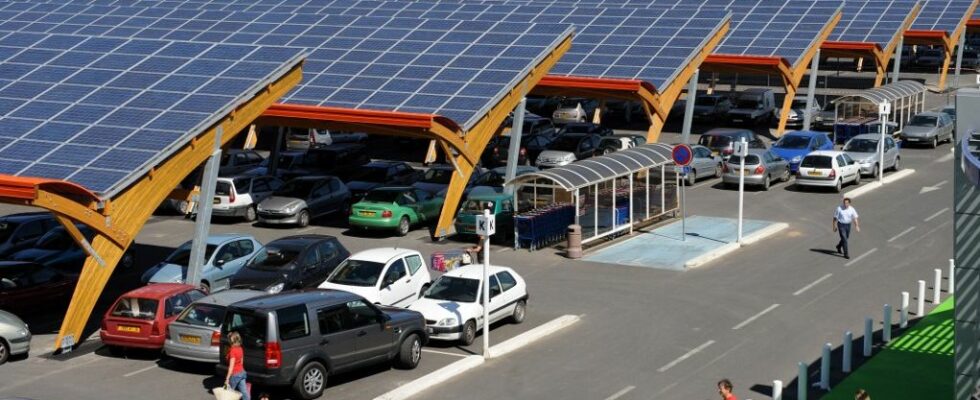For the hospital center of Evreux, it is done. For the past fortnight, it has been equipped with 4,400 photovoltaic panels which will produce approximately 25% of the electricity consumed by the hospital. Admittedly, the major part is installed on the ground, on a wasteland of the site. But another, around 25%, takes the form of canopies covering the staff car park,” says Edouard Roblot, director of low-carbon buildings at idexa company specializing in renewable energies, which operated this project.
Those photovoltaic carports should bloom in the next few years. The “acceleration of renewable energies” bill, which will be voted on this Tuesday at the Assembly, plans to make them compulsory for outdoor car parks of more than 1,500m² over at least half of their area. First those of shopping centers. Edouard Roblot also adds those of hospitals, factories, company headquarters, or even carpooling areas and relay parking lots that are growing on the outskirts of large cities. They too quickly reach 1,500 m².
Another measure that could move?
Car parks over 10,000m² will have until July 1, 2026 to comply when the smaller ones are two years older. After these deadlines, the owners will be liable to a fine of up to 40,000 euros per year. Everything is still written in the conditional while the bill is still under discussion and this measure has already evolved a lot. Initially, the government had, for example, set the threshold of the car parks concerned at 2,500m². Too unambitious for the ecologists who wanted to lower it to 250m². In the end, there is this compromise found around the 1,500m² which should no longer move, but it only applies to the National Assembly, says Jules Nyssen, president of the Syndicate of Renewable Energies (SER). On this subject, the Senate’s proposal was quite different. » It will be at the joint committee (CMP), composed of deputies and senators, to find a compromise. She will attack the text from January 16.
Be that as it may, neither Jules Nyssen nor Edouard Roblot imagine the measure disappearing. It must be said that the installation of photovoltaic carports on car parks ticks many boxes. “We know how to do it, the technology is mature, begins Edouard Roblot. The solarization of a car park can be done in eighteen months, it’s very fast. “It’s less complex than installing solar power on the roofs of residential buildings, for which the constraints can be numerous,” confirms Jules Nyssen.
A deposit far from negligible?
Another advantage for the president of the SER: “Very often, these projects cost nothing to the owners of the car park”. In the most common economic model, car parks are indeed rented to solar developers who are responsible for investing and building these shade structures. They then find their account by reselling the energy produced. Some, if not all, of this electricity is resold to car park owners for self-consumption. “That’s another advantage then of these photovoltaic shade houses, continues Edouard Roblot. Not only is this electricity less expensive than on the market, because purchased without an intermediary, but it also makes it possible to provide new services. » Typically to supply charging stations, a need that will grow. “Today, a photovoltaic shade project is the service station of tomorrow,” sums up low-carbon building director at Idex.
But the main advantage of solarising car parks lies elsewhere. It is in the very nature of these surfaces. Or already artificialized areas. Unlike forests or agricultural land that developers of solar projects can also covet. And the potential of these car parks is far from negligible. In its impact study, the bill estimated between 90 and 150 million square meters of car parks of more than 2,500 m² likely to be equipped with carports. For a power rated at 9 gigawatts/peak (GW). Which is not nothing when the total power of the French photovoltaic park reached 15.8 GW at the end of the third quarter of 2022.
Lowering the threshold to 1,500 m² should release an even larger deposit. “It is difficult to estimate precisely, knowing that some of the car parks concerned cannot be solarized for technical reasons, begins Edouard Roblot. Nevertheless, the 10 GW milestone seems very easily achievable and, if you don’t get it right, you could hope for double it. “Is therefore potentially more than what has been installed in France to date.
“We could go further”
“In the project, it is undoubtedly the most favorable measure for the deployment of solar energy, the one that frees up the most land”, also believes Jules Nyssen. “We could have gone even further”, regrets, for his part, Charles Fournier. The EELV deputy for Indre-et-Loire does not think of the desire of his group to extend the obligation of shade structures to car parks of 250 m². ” L’article 11b, introduced by the Senate, made the installation of a renewable energy production process mandatory on a surface of the roof or the facades of administrative, commercial and industrial buildings, he recalls. The National Assembly removed it. It’s a real setback. We could thus have anticipated future European regulations. »
For Charles Fournier, in any case, “this acceleration of the deployment of renewable energies must be done as much as possible and as a priority on areas that have already been artificialized and neglected in order to impact biodiversity as little as possible and protect our food sovereignty”. A vision that worries the SER where we recall that in his speech in Belfort, on February 10, Emmanuel Macron had expressed his desire to exceed 100 GW of solar installations by 2050. “If we are satisfied with car parks , roofs, wasteland…, we will never be there”, warns Jules Nyssen.

